In a sea of Thanksgiving pies, this cake stands tall.
Prep: 90 mins
Cook: 81 mins
Total: 2 hrs 51 mins
Servings: 12 to 16 servings
Yield: 1 8-inch 3-layer cake
Sweet potato casserole has always been my favorite dessert disguised as a side dish. When I was little, I always felt like I was getting away with an extra treat when it showed up at big holiday meals like Thanksgiving. This sweet potato casserole cake removes that disguise, giving it a well-deserved place at the dessert table for Thanksgiving or any other cozy celebration.
Sweet Potato Casserole Nostalgia
I grew up with sweet potato casserole topped with mini marshmallows that toast into a sweet and gooey topping that I loved as a kid. But a few years ago, a friend from St. Louis shared her family’s recipe featuring a sweet and crunchy pecan streusel, and I’ve been making that version ever since. But if we’re lifting the side dish disguise anyway, why not combine the best of both versions to include crunchy pecans and toasted marshmallows?
The Ingredients
Sweet potatoes roasted until they’re extra sweet and tender form the base of the cake batter. The smell of the caramelized juices on the baking sheet is hard to pass up, but you can cook them faster in the microwave or buy canned sweet potato purée instead. As a nod to the pecan streusel, the cake batter is entirely sweetened with brown sugar and studded with nutty, toasted pecans.
For the marshmallow element, I cover the cake with Swiss meringue and toast the beautiful swoops and swirls with a kitchen torch. Meringue and marshmallows aren’t exactly the same, as marshmallows include gelatin, giving them that chewy texture in addition to their fluffiness. But meringue is easy to spread and tastes just like marshmallows, especially when toasted.
Buttercream Tips
For best results when making the buttercream, the meringue and the butter should be the same temperature (ideally between 72 and 75 F). If one element is significantly cooler or warmer than the other, the buttercream may curdle. If it does curdle, don’t panic!
If the buttercream looks soupy, it is too warm. Place the mixer bowl in the fridge for 10 minutes, then try whipping it until smooth. Repeat this process until the buttercream comes together.
If it appears chunky or very stiff and grainy, it is too cold. Place the mixer bowl briefly over a hot water bath (the water should be steaming, not boiling). When you see a little melting around the edges, place the bowl back on the mixer and beat with the whisk attachment until smooth. Repeat this process as needed.
A Note on Sweet Potatoes
Confusingly, sweet potatoes and yams are not the same, and yams will not work for this cake. Yams are drier, starchier, and not as sweet. The good news for this recipe is that true yams are difficult to find in U.S. supermarkets, so you’re unlikely to end up with the wrong tuber. The confusion stems from the lack of consistent names or labels for varieties of sweet potatoes and yams in stores. Whether the store uses yam or sweet potato on the label, I always stick to Garnet or Jewel varieties when baking. They’re sweet and the flesh is a beautiful deep orange.
Tips for Making This Sweet Potato Casserole Cake
- Use a microwave to save time—Sweet potatoes roasted in the oven have a sweeter, more caramelized flavor, but to save time, you can cook them in the microwave instead. Prick the sweet potatoes all over with a fork, set them on a plate, and microwave on high power for 5 minutes, pausing halfway through the cooking time to flip them over. Continue cooking in 30-second bursts until tender.
- How to toast the pecans—If your pecans aren’t already toasted, you can spread them on a separate baking sheet and toast them for 5 minutes while you roast the sweet potatoes.
- Use canned sweet potato puree—Canned sweet potato puree will work just as well as freshly roasted sweet potatoes. Pumpkin and squash would be delicious too, but they have a higher moisture content than sweet potatoes. If you choose to use them, omit the milk.
- Meringue tips—For the lightest meringue, use fresh, room-temperature eggs. When separating the eggs, be careful not to get any of the yolk in the egg whites or they won't foam properly. The cream of tartar is optional but makes the meringue more stable. If you don’t have any in the cupboard, substitute with 1 teaspoon lemon juice, or leave it out.
Make Ahead
- Make the puree—The sweet potato purée will keep for up to 3 days in an airtight container in the refrigerator.
- Bake the cakes—The cake layers can be made ahead of time and stored, well-wrapped, at room temperature for up to 2 days, or in the freezer for up to 3 months.
- Prepare the meringue and buttercream—The meringue and buttercream can be made a day in advance and stored in airtight containers in the refrigerator. Let them come to room temperature before assembling and frosting the cake.
Ingredients
For the Cake
-
2 large sweet potatoes, about 25 ounces, to yield 2 cups (488 grams) puree
-
2 1/4 cups (270 grams) all purpose flour
-
1 teaspoon baking powder
-
1 teaspoon baking soda
-
1/2 teaspoon fine salt
-
3/4 cup (170 grams) unsalted butter, room temperature
-
1 1/2 cups (320 grams) light brown sugar
-
3 large eggs, room temperature
-
1 tablespoon vanilla extract
-
1/3 cup (76 grams) whole milk
-
3/4 cup (86 grams) toasted pecans, finely chopped
For the Meringue and Marshmallow Buttercream Filling
-
1/2 cup (113 grams) unsalted butter, room temperature
-
4 large egg whites
-
1 cup (200 grams) granulated sugar
-
1/2 teaspoon cream of tartar
-
1/4 teaspoon fine salt
-
1 tablespoon vanilla extract
-
1 1/4 cups (140 grams) confectioners' sugar
Steps to Make It
Make the Cake
-
Gather the ingredients. Position a rack in the center of the oven and heat to 400 F. Line a baking sheet with aluminum foil.

-
Scrub 2 large (about 25 ounces) sweet potatoes clean, pat dry, and prick them all over with a fork. Place the sweet potatoes on the lined baking sheet and roast until tender, about 1 hour. When done, you should be able to easily pierce the center of the sweet potatoes with the tip of a sharp knife. Remove from the oven and let them cool until they can easily be handled.
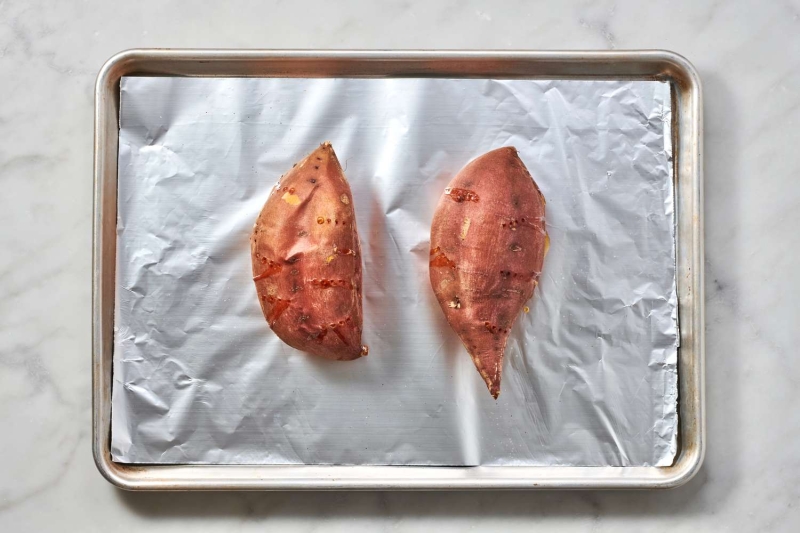
-
Reduce the oven temperature to 350 F. Lightly grease and flour three 8-inch round cake pans.
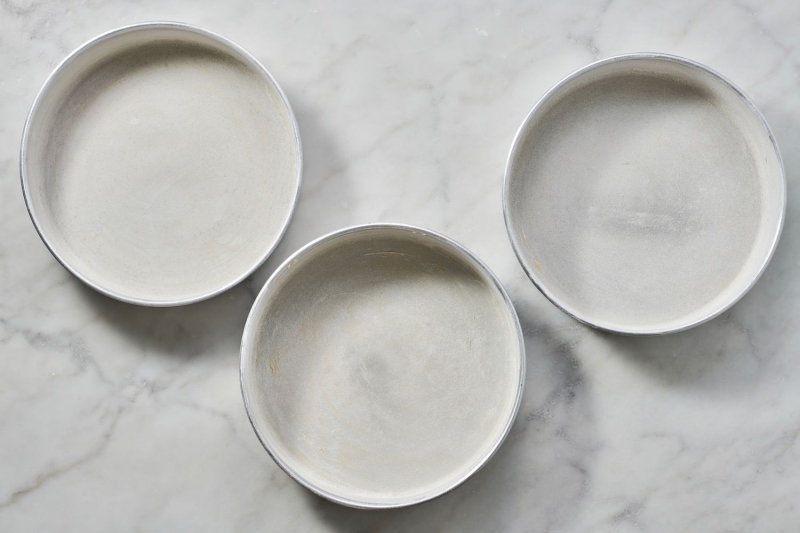
-
Slice the sweet potatoes in half lengthwise and use a spoon to scoop the flesh of the sweet potatoes into a bowl, discarding the skins. For the smoothest texture, purée the sweet potatoes with a hand blender or in the food processor, or you can mash them by hand with a potato masher. Measure 2 cups (488 grams) of the purée for the cake batter and set aside. If you have extra, you can save it for another use.
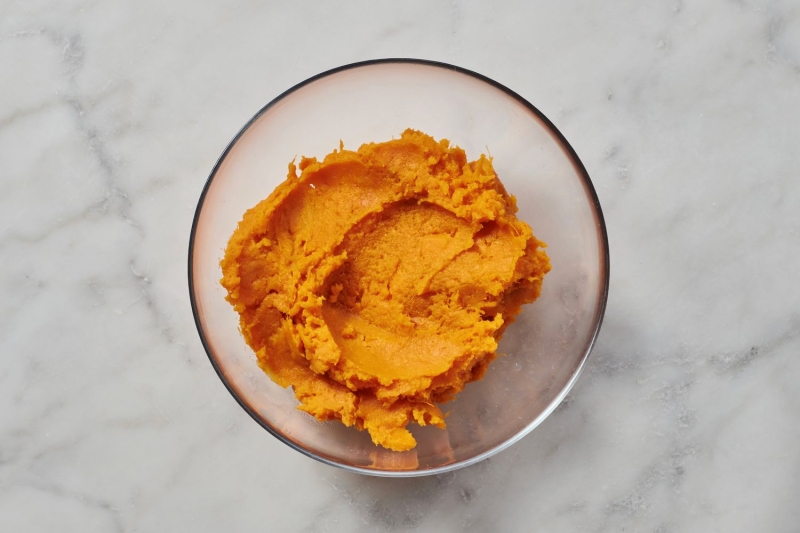
-
Whisk together 2 1/4 cups (270 grams) all-purpose flour, 1 teaspoon baking powder, 1 teaspoon baking soda, and 1/2 teaspoon fine salt in a medium bowl.
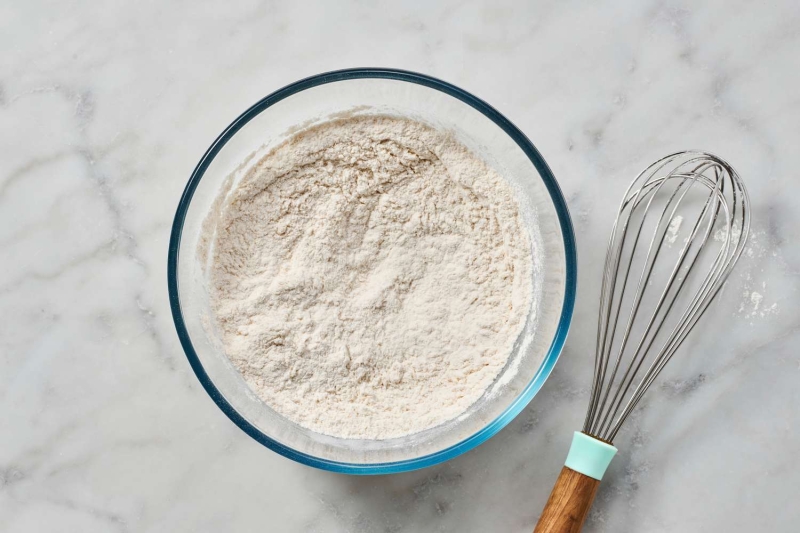
-
Beat 3/4 cup (170 grams) unsalted butter and 1 1/2 cups (320 grams) light brown sugar in a stand mixer fitted with the paddle attachment on medium speed until pale and fluffy, about 4 minutes.
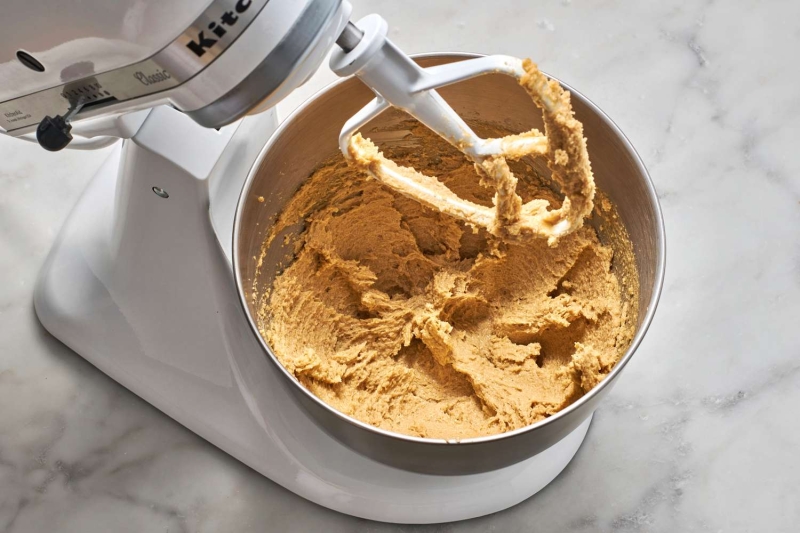
-
Beat in 3 large eggs, one at a time, on medium speed, scraping the bowl with a spatula between additions.
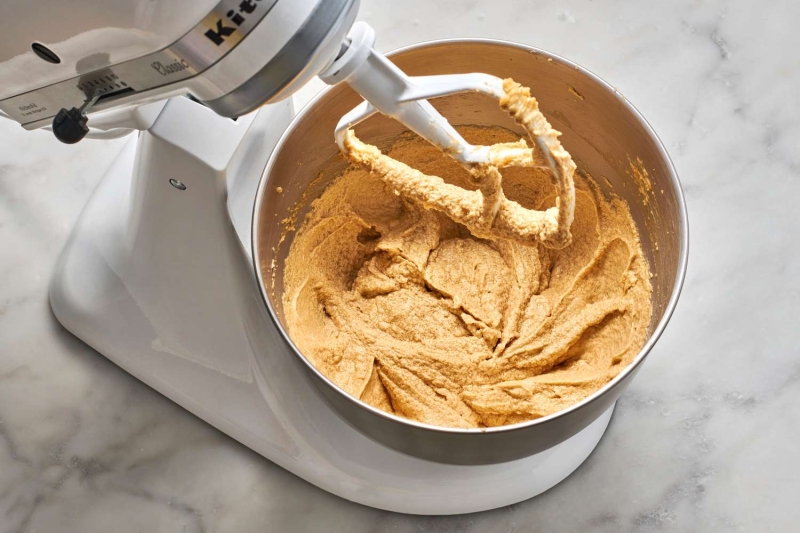
-
Add the sweet potato purée and 1 tablespoon vanilla extract and mix on low speed until fully combined.
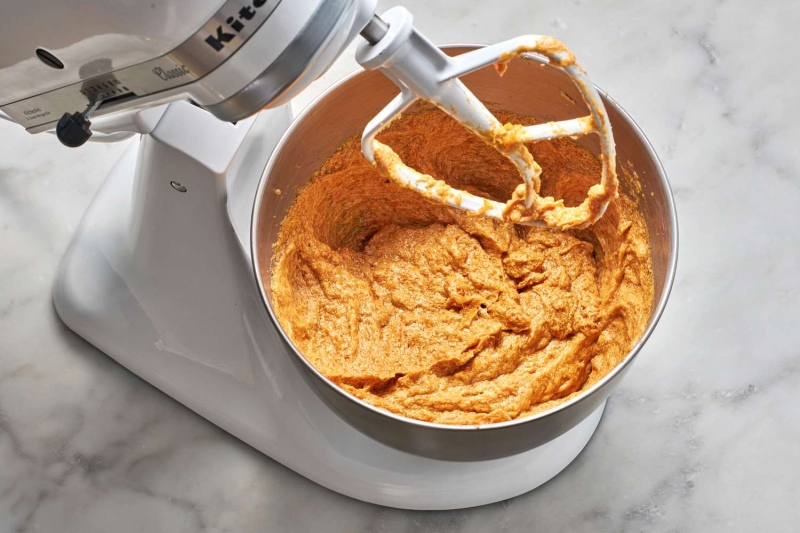
-
Add half of the flour mixture and beat on low speed until incorporated. Pour in 1/3 cup (76 grams) whole milk and continue mixing on low speed. Add the rest of the flour mixture and mix just until combined.
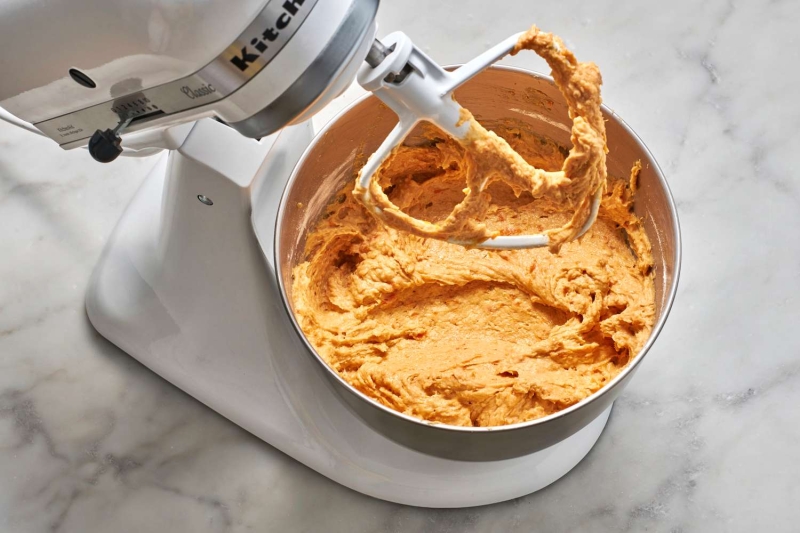
-
Use a spatula to scrape down the bottom and sides of the mixing bowl. Add the 3/4 cup (86 grams) toasted pecans and stir to distribute through the batter.

-
Divide the batter evenly among the prepared cake pans and smooth the tops. If you have a kitchen scale, scale about 18.5 ounces (530 grams) of batter per pan.
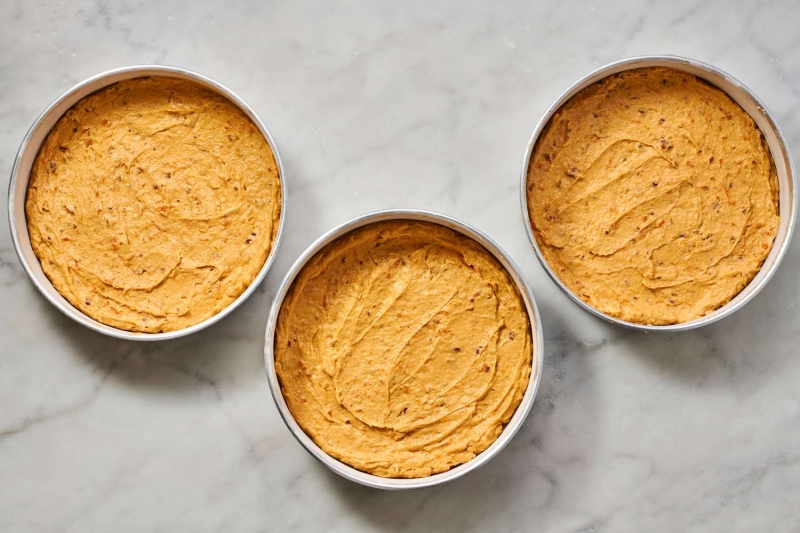
-
Bake for 21 minutes. The edges should just be starting to pull from the sides of the pan and turning golden. A toothpick inserted into the center of one of the cake layers should come out clean or with a few crumbs sticking to it.

-
Cool the cakes in the pans for 5 minutes, then run an offset spatula or butter knife around the edge of the cakes and carefully turn them out onto a wire rack to cool completely.
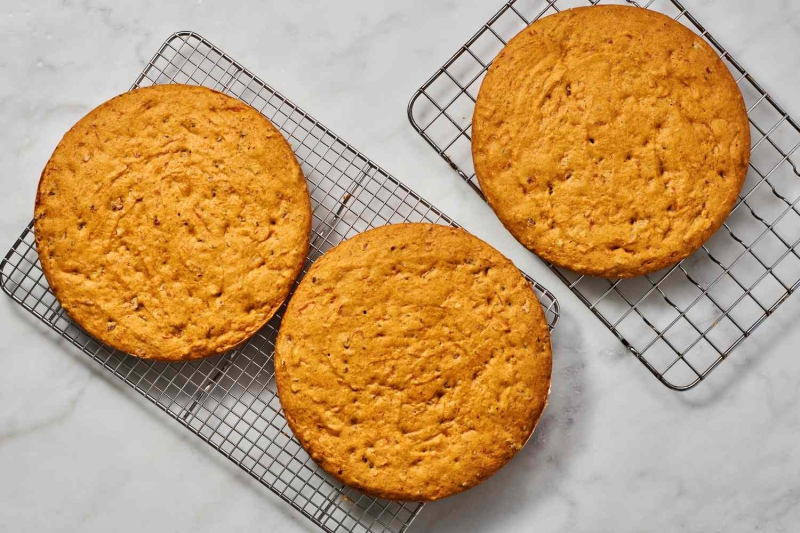
Make the Frosting and Assemble
-
Gather the ingredients.
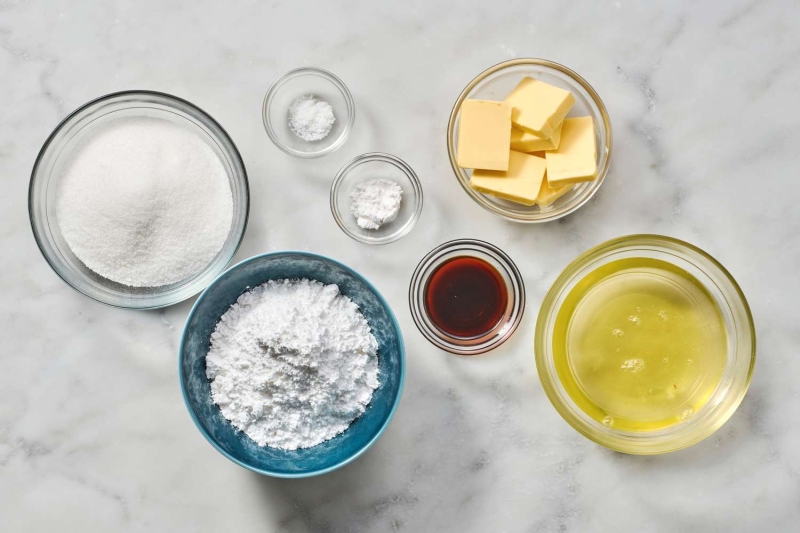
-
To make the meringue combine the 4 large egg whites, 1 cup (200 grams) granulated sugar, 1/2 teaspoon cream of tartar, and 1/4 teaspoon fine salt in the bowl of a stand mixer fitted with the whisk attachment.
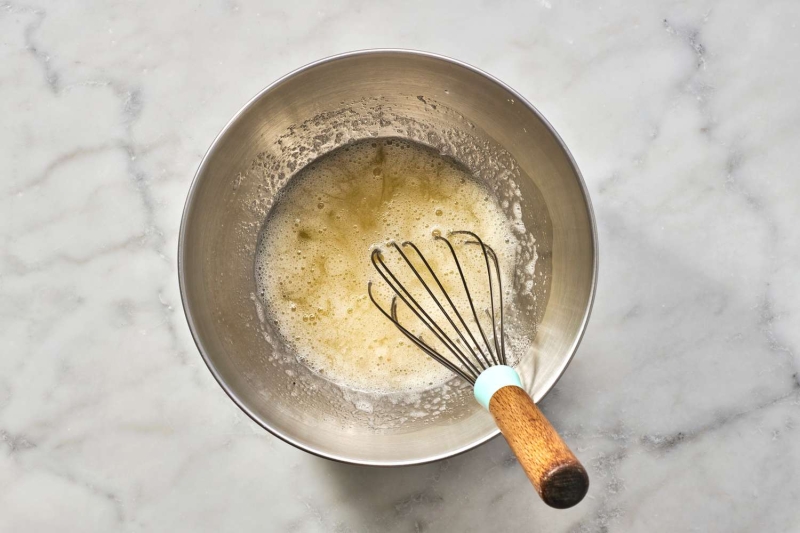
-
Set up a bain-marie by placing the bowl over a pot of simmering water on low heat. Adjust the water level in the pot to ensure that the bottom of the bowl doesn’t come into contact with the water.
Heat the egg whites in the bain-marie, stirring constantly, until an instant thermometer reads 160 F. At this point, you’re not whipping the egg whites yet. The aim of stirring constantly is to heat the egg whites evenly and prevent them from scrambling.
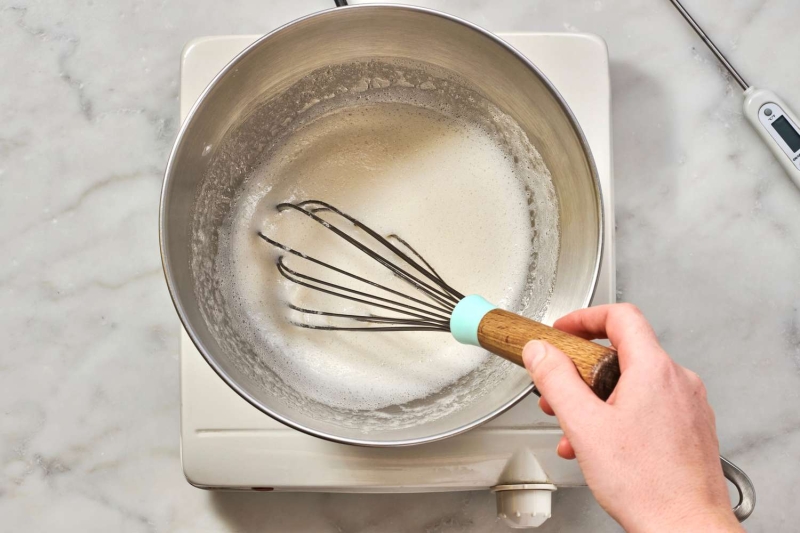
-
Once the egg whites reach 160 F, remove the bowl from the bain-marie and place it in the stand mixer. Add 1 tablespoon vanilla extract. Whip the egg whites for 5 minutes to stiff peaks. The meringue should be bright white and shiny, have gathered around the whisk, and stick up in a sharp point when the whisk is removed from the bowl.
Remove 2/3 of the meringue (about 227 grams) into a small bowl and set aside to save for frosting the outside of the cake.
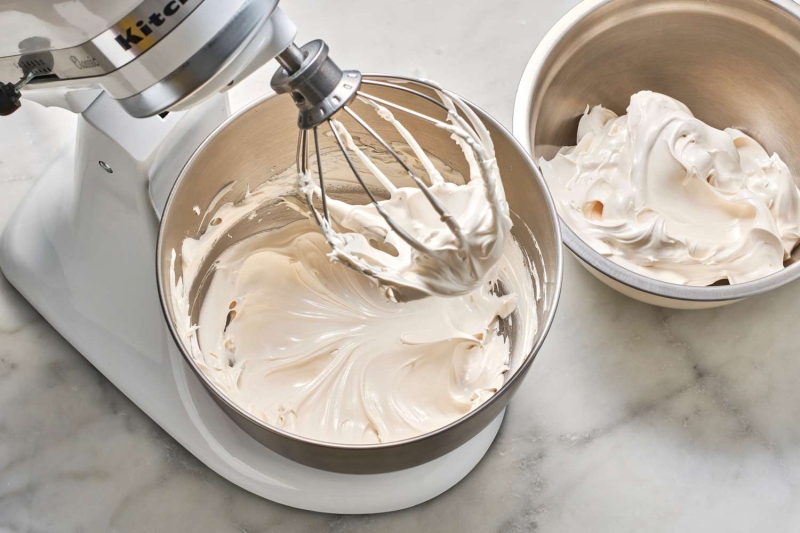
-
To make the marshmallow buttercream filling, continue beating the remaining 1/3 of the meringue on medium-high speed. With the mixer running, slowly add 1/2 cup (113 grams) unsalted butter, at room temperature a small piece at a time, waiting until it has incorporated into the meringue before adding the next pat.
Pause the mixer, scrape down the bottom and sides of the bowl with a silicone spatula, and mix for 30 seconds to ensure the buttercream is fully combined and smooth.
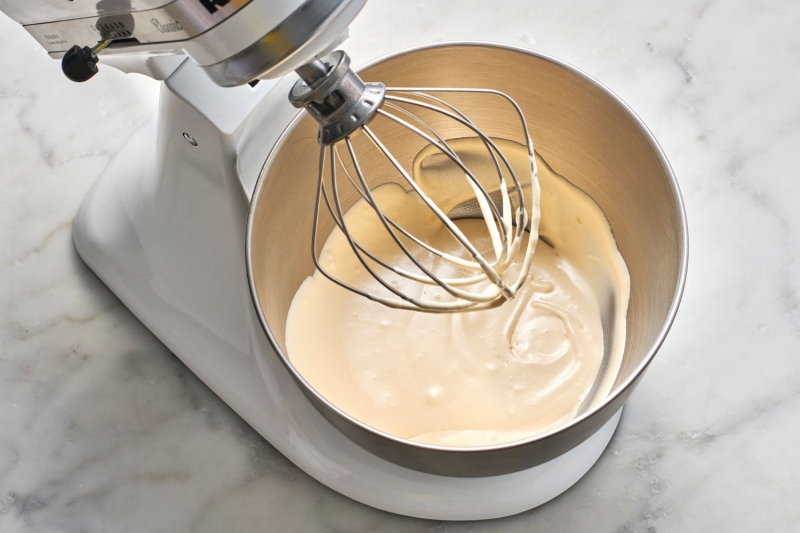
-
Add 1 1/4 cups (140 grams) confectioners’ sugar. Mix on low speed until combined, then increase the speed to medium and beat for 1 minute until the buttercream is smooth and creamy.
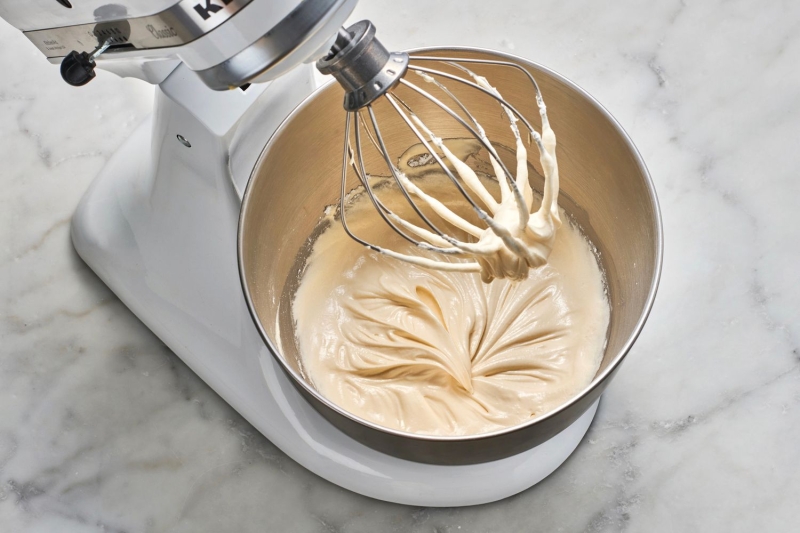
-
To assemble, place a cake layer on a large plate or cake stand. Use an offset spatula or the back of a spoon to spread half of the marshmallow buttercream filling evenly over the cake layer. Repeat with the second layer. Top with the final cake layer, placing it upside down. Ensure that all of the layers are centered and that the top of the cake is level, adjusting gently if needed.
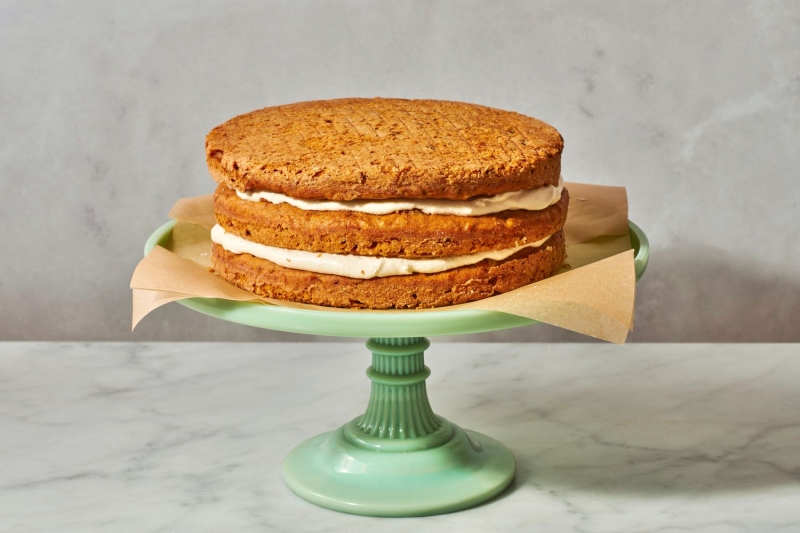
-
To frost the cake, spread the meringue over the top and sides of the cake in an even layer. Use an offset spatula or the back of a spoon to make swirls and swoops in the meringue.
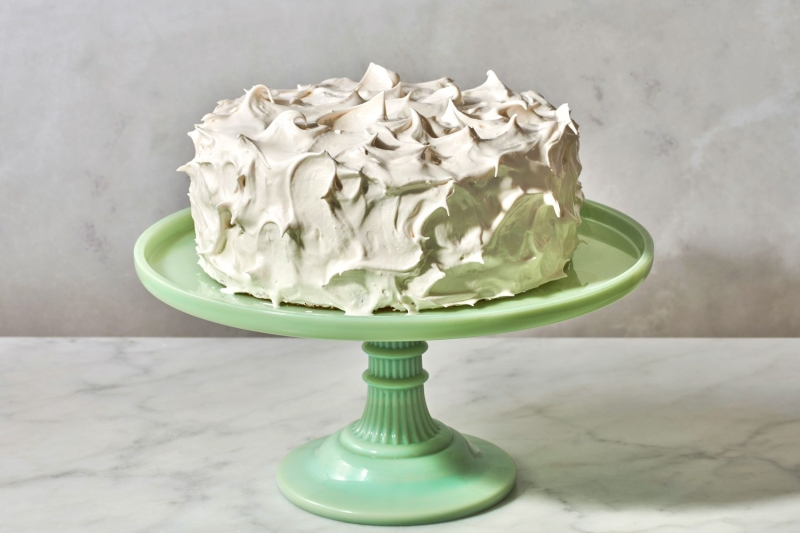
-
Toast the meringue with a culinary torch until the swirls and swoops turn golden brown.
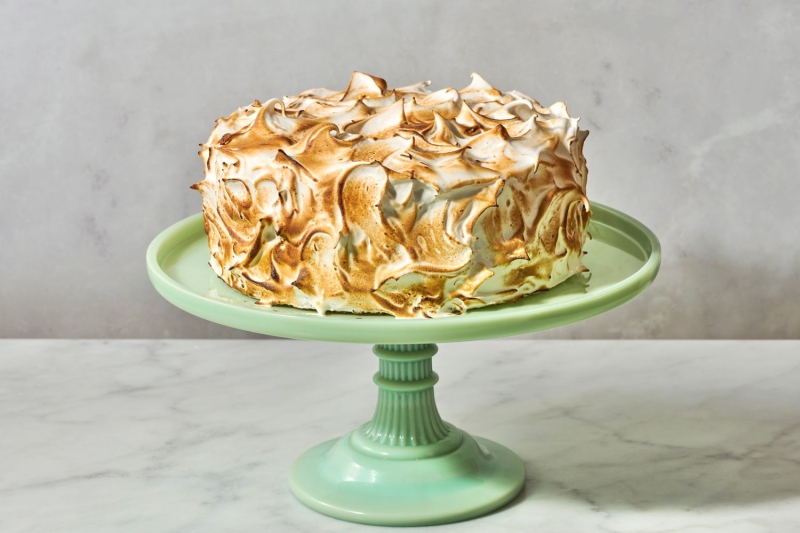
How To Store
- Store the cake in an airtight container in the refrigerator for up to three days. After slicing, I like to cover the exposed cake layers with parchment paper or a sheet of plastic wrap to keep them from drying out.
- The baked and cooled cake layers can be frozen for up to 3 months. Wrap each layer first in plastic wrap, then in aluminum foil. To defrost, transfer the wrapped cakes to thaw in the refrigerator overnight.
Feeling Adventurous? Try This:
- Use walnuts or omit the nuts—You can substitute the pecans with toasted walnuts or skip the nuts entirely.
- Add spices—To keep this cake true to the savory recipe that inspired it, I don't call for any spices. But adding some spice, whether just a teaspoon of cinnamon or a tablespoon of pumpkin pie spice, would add a warm boost of autumnal flavor. I love adding a teaspoon of ground cardamom.
- Use the meringue to frost and fill the cake—Compared to the meringue, using marshmallow buttercream for the filling adds extra structure for stable stacking, not to mention the richness of the butter. If you're looking to simplify the recipe though, you can skip the buttercream and use just the meringue for assembling and frosting the cake.
- Make a 9-inch cake—You can also bake two 9-inch layers instead of the towering three 8-inch layers. Divide the batter evenly between two greased 9-inch round cake pans and bake for 30 to 35 minutes at 350 F. You may have extra meringue and buttercream.
| Nutrition Facts | |
|---|---|
| Servings: 12 to 16 | |
| Amount per serving | |
| Calories | 437 |
| % Daily Value* | |
| Total Fat 19g | 25% |
| Saturated Fat 10g | 48% |
| Cholesterol 73mg | 24% |
| Sodium 257mg | 11% |
| Total Carbohydrate 61g | 22% |
| Dietary Fiber 2g | 7% |
| Total Sugars 43g | |
| Protein 5g | |
| Vitamin C 6mg | 30% |
| Calcium 67mg | 5% |
| Iron 1mg | 8% |
| Potassium 267mg | 6% |
| *The % Daily Value (DV) tells you how much a nutrient in a food serving contributes to a daily diet. 2,000 calories a day is used for general nutrition advice. | |


